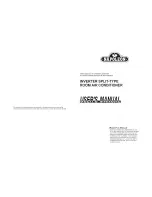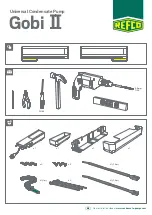
En-6
Top view
Drain pan
100mm
Drain hose
Drain hose insulation
(Accessories)
Hose opening view
Wind the attached heat insulation around the
hose band. Make sure the alignment is on top.
A. Floor type
Be sure to arrange the drain hose so that it is leveled lower than the drain hose connect-
ing port of the indoor unit.
Drain
hose
Lift up
Trap
Good
No good
No good
Arrange the drain
hose lower than
this portion.
CAUTION
Do not install the unit so that the drain hose side is too high. Height A should be less
than 5 mm.
A
A
Drain hose
No good
No good
B. Ceiling type
Be sure to arrange the drain hose so that it is leveled lower than the drain hose connect-
ing port of the indoor unit.
Lift up
Drain hose
Good
No good
Arrange the drain
hose lower than
this portion.
When drain hose is arranged backward.
Secure the drain hose with the VT wire.
VT wire
hole
Pass the drain hose
through here.
Base (Bottom)
Intake grille
Cut the grille
Drain hose
VT wire
6. ELECTRICAL WIRING
Cable
Cable size (mm
2
)
Type
Remarks
Connection cable
1.5 (MIN.)
Type 60245 IEC57 Ground, 1
φ
230V
Max. Cable Length: Limit voltage drop to less than 2%. Increase cable gauge if voltage drop is
2% or more.
For simultaneous multi
Conductor size (mm
2
)
Max length (m)
Bus wire
0.3 (MIN.)
500*
This length shall be the total extended length in the system of the group
.
(Total length of bus wire and remote controller cable.)
WARNING
Electrical work must be performed in accordance with this Manual by a person certi
fi
ed
under the national or regional regulations. Be sure to use a dedicated circuit for the unit.
An insuf
fi
cient power supply circuit or improperly performed electrical work can cause
serious accidents such as electric shock or
fi
re.
Before starting work, check that power is not being supplied to the indoor unit and
outdoor unit.
Use the included transmission cables and power cables or ones speci
fi
ed by the
manufacturer. Improper connections, insuf
fi
cient insulation, or exceeding the allowable
current can cause electric shock or
fi
re.
For wiring, use the prescribed type of wires, connect them securely, making sure that
there are no external forces of the wires applied to the terminal connections. Improp-
erly connected or secured wires can cause serious accidents such as overheating the
terminals, electric shock, or
fi
re.
Do not modify the power cables, use extension cables, or use any branches in the wir-
ing. Improper connections, insuf
fi
cient insulation, or exceeding the allowable current can
cause electric shock or
fi
re.
Match the terminal block numbers and connection cable colors with those of the outdoor
unit or branch box. Erroneous wiring may cause burning of the electric parts.
Securely connect the connection cables to the terminal blocks. In addition, secure the
cables with wiring holders. Improper connections, either in the wiring or at the ends of
the wiring, can cause a malfunction, electric shock, or
fi
re.
Always fasten the outside covering of the connection cable with the cable clamp. (If the
insulator is chafed, electric leakage may occur.)
Securely install the electrical box cover on the unit. An improperly installed electrical box
cover can cause serious accidents such as electric shock or
fi
re through exposure to
dust or water.
Install sleeves into any holes made in the walls for wiring. Otherwise, a short circuit
could result.
Install a earth leakage breaker. In addition, install the earth leakage breaker so that the
entire AC main power supply is cut off at the same time. Otherwise, electric shock or
fi
re
could result.
Always connect the earth wire.
Improper grounding work can cause electric shocks.
Install the remote controller cable and bus wire so as not to be direct touched with your
hand.
(1) Use ring terminals with insulating sleeves as shown in the
fi
gure below to connect to
the terminal block.
(2) Securely clamp the ring terminals to the wires using an appropriate tool so that the
wires do not come loose.
(3) Use the speci
fi
ed wires, connect them securely, and fasten them so that there is no
stress placed on the terminals.
(4) Use an appropriate screwdriver to tighten the terminal screws. Do not use a screw-
driver that is too small, otherwise, the screw heads may be damaged and prevent the
screws from being properly tightened.
(5) Do not tighten the terminal screws too much, otherwise, the screws may break.
(6) See the table 1 for the terminal screw tightening torques.
Strip 10 mm
Sleeve
Ring terminal
Screw with
special washer
Screw with spe-
cial washer
Ring terminal
Ring
terminal
Wire
Wire
Terminal block
Terminal
board
Table 1
Tightening torque
M4 screw
1.2 to 1.8 N·m (12 to 18 kgf·cm)
WARNING
Use crimp-type terminals, and tighten the terminal screws to the speci
fi
ed torques. Other-
wise, overheating may be produced, and possibly cause heavy damage inside the unit.
9374318445-05_IM.indb 6
4/6/2012 10:08:16 AM

































